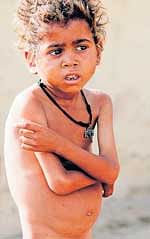Extreme poverty still pervades India

The “Millennium Development Goals: 2010 Progress Report” says that while India is expected to reduce its poverty rate from 51 per cent in 1990 to 24 per cent in 2015, progress in the rest of South Asia was slow and not sufficient to cut poverty to half.
Efforts to achieve a double digit rate of growth by 2012 are on but this achievement will not enable us to reduce poverty as per the millennium goals.
The report released on Wednesday reveals that South Asia has a large percentage of people in “so- called vulnerable employment characterised by inadequate earnings, substandard working conditions and a lack of formal work arrangements and benefits.
South Asia has the second largest rate of vulnerable employment among all regions, next to sub-Saharan Africa,” poorest part of the world.
Slow progress
The MDG report said that South Asia has made a slow progress against hunger and the prevalence of hunger in the region actually increased between 2000-2002 and 2005-2007 from 20 to 21 per cent.
The report reveals that South Asia has the highest rate of child malnutrition in the world with 51 per cent of children younger than five years underweight in 2008, down a negligible 5 percentage points from 51 per cent.
“In India, too, the percentage of undernourished population could be reduced from 24 per cent to 21 per cent only,” it said.
However, the report noted that that South Asia has performed better as far as reduction child mortality is concerned. The number of child deaths per 1,000 live births dropped from 121 in 1990 to 74 in 2008. In India it reduced from 83 in 1990 to 54 in 2007.
Primary education
South Asia has done its best in providing universal primary education. It has reached 90 per cent in 2008 and it will achieve the goal by 2015.
In primary education, girls are catching up, but in secondary and tertiary education the gender inequality is still there with 87 and 76 per boys enrolled respectively, in 2008.
“In South Asia, gender inequality is education is mirrored by inequality in the labuor market. Only 20 per cent of those employed outside agriculture are women. And only 9 per cent of senior or managerial positions are held by women,” said the report.
The millennium goals are too distant for the region even in ensuring environmental sustainability. No progress could be made in this direction, according to the report.